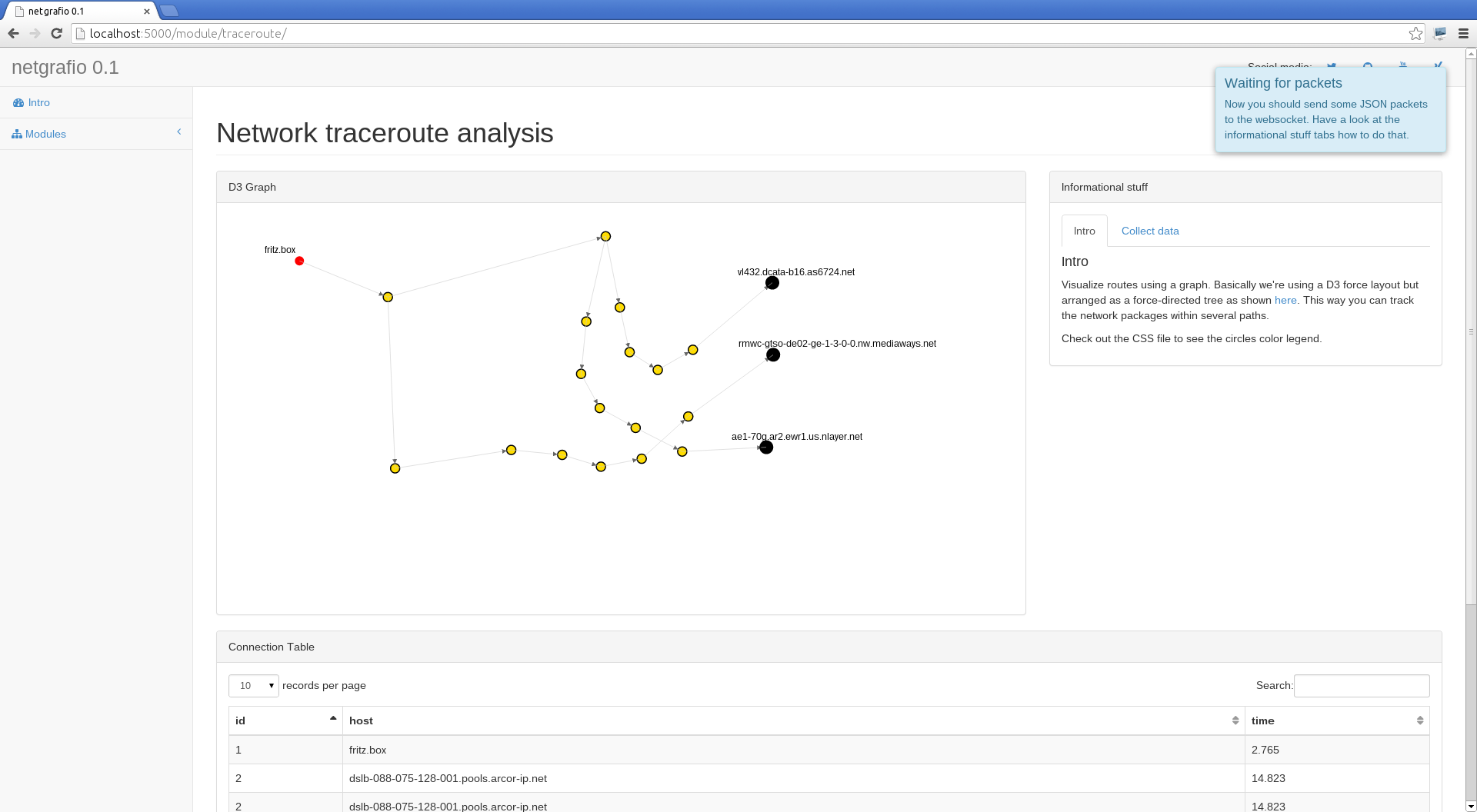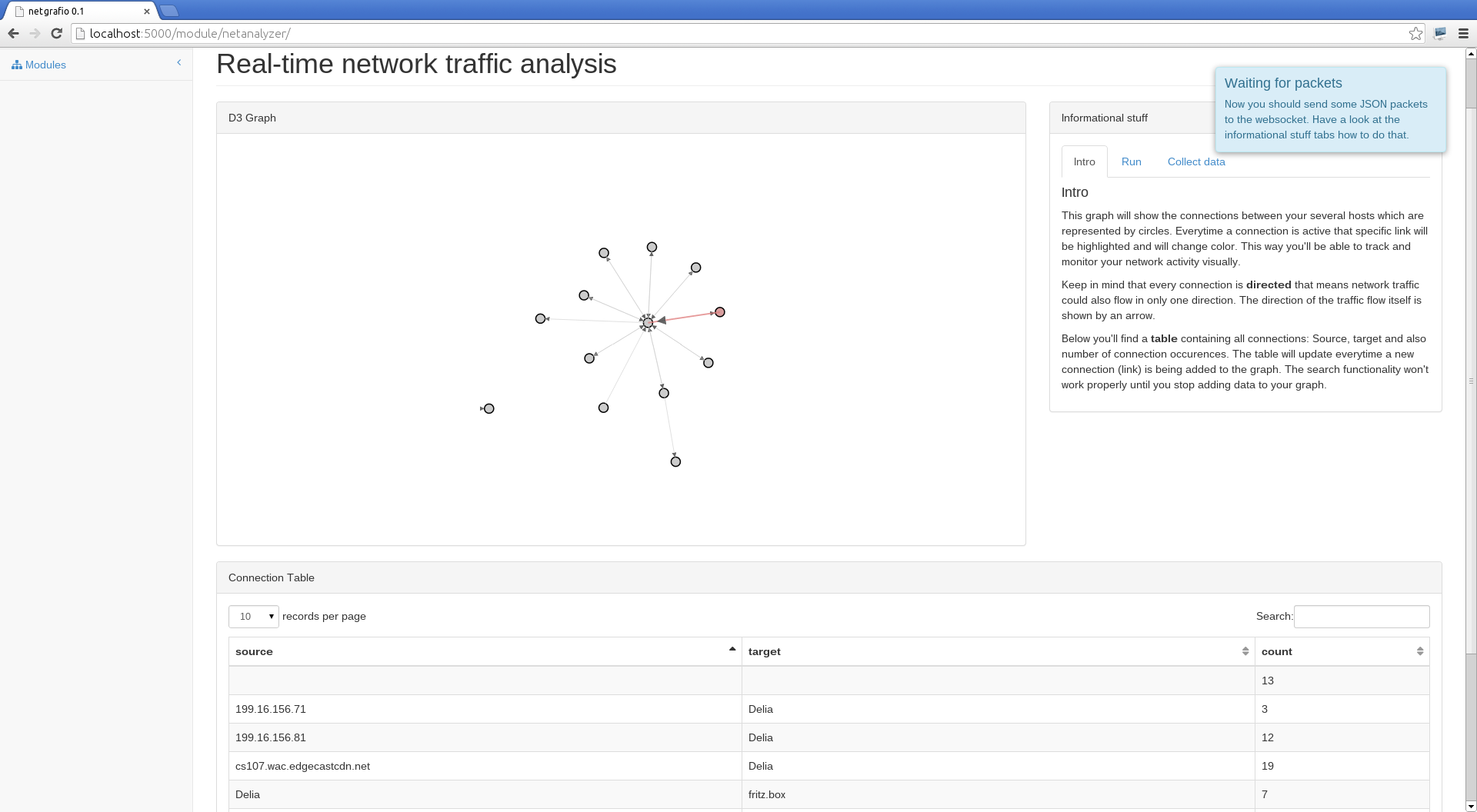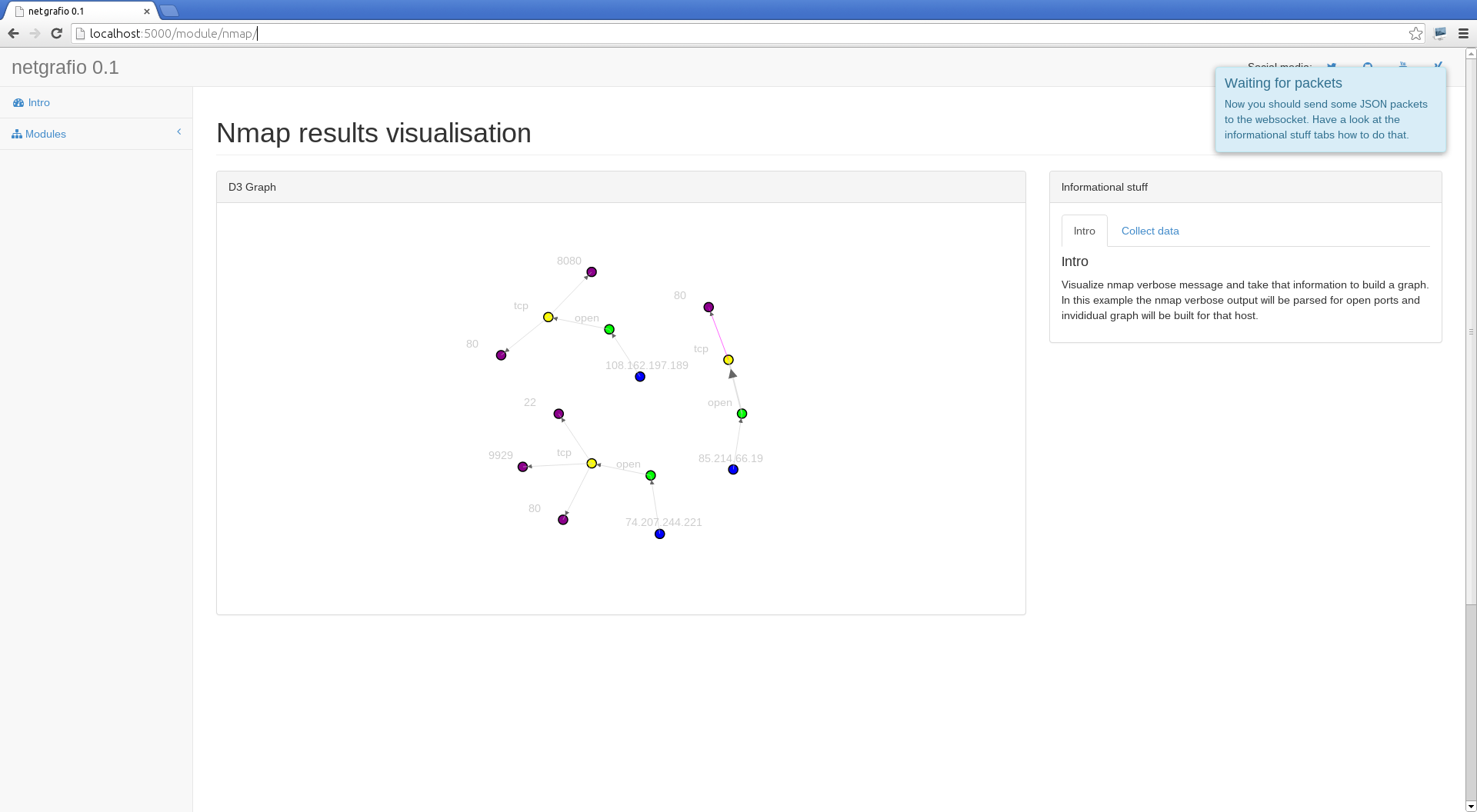Welcome to netgrafio’s documentation!¶
Contents:
Quickstart¶
Make sure you have installed all the requirements on your system (specified in README.md). Afterwards you can clone this project:
$ git clone https://github.com/nullsecuritynet/netgrafio
$ cd netgrafio
Now you’ll need to setup a isolated python environment using virtualenv:
$ virtualenv env
Using base prefix '/usr'
New python executable in env/bin/python3
Also creating executable in env/bin/python
Installing setuptools, pip...done.
Make sure to activate the virtual environment:
$ source env/bin/activate
Having set the virtualenv environment let’s install some missing packages:
$ pip install -r env/requirements.pip
Now you’re ready to start netgrafion and have some fun.
These are the basic parameters:
$ python netgrafio.py -h
usage: netgrafio.py [-h] [--tcp-port TCP_PORT] [--ws-port WS_PORT]
[--web-port WEB_PORT] [--host HOST]
netgrafio - visualize your network
optional arguments:
-h, --help show this help message and exit
--tcp-port TCP_PORT Specify TCP port to listen for JSON packets (default:
8081)
--ws-port WS_PORT Specify WebSocket port to send JSON data to (default:
8080)
--web-port WEB_PORT Specify web port to server web application (default:
5000)
--host HOST Specify host to bind socket on (default: 127.0.0.1)
If you start netgrafio without any arguments, then you’ll have a
- TCP-Socket listening on port 8081
- WebSocket listening on port 8080
- Web-Application available at http://localhost:5000
After starting netgrafio:
$ python netgrafio.py
2014-04-24 16:18:12,984 - INFO - [WebSocketServer] - Starting WebSocket server on port 8080
2014-04-24 16:18:12,984 - INFO - [WebSocketServer] - Start collector server
2014-04-24 16:18:12,985 - INFO - [WebSocketServer] - Waiting for incoming data ...
2014-04-24 16:18:12,989 - INFO - [WebServer] - Listening on 5000
2014-04-24 16:18:12,989 - INFO - [TCPServer] - Listening on 8081
Now open your browser and navigate to http://localhost:5000
D3 Graph¶
This section describes the basic API of d3.graph.min.js. It describes how to build a graph using D3.
- class D3Graph(container)¶
Create a new D3 graph.
Arguments: - container (string) – Specify the element in the DOM where to show the graph
Returns: Instance of class D3Graph (SVG element)
Example:
myGraph = new D3Graph("#myElement");
- D3Graph.init()¶
Initialize the graph.
Example:
myGraph.init()
- D3Graph.start()¶
Start the graph.
Example:
myGraph.start()
- class D3GraphController(d3graph)¶
Control the D3 graph.
Arguments: - d3graph (D3Graph) – Object of type D3Graph.
Returns: Instance of class D3GraphController
Example:
myGraph = new D3Graph("#myElement"); graphController = new D3GraphController(myGraph);
- D3GraphController.addNode(nodeObject)¶
Add new node to the graph.
Arguments: - nodeObject (object) – Node object to be added to the graph
Example:
nodeObject = { "id": "some_unique_id" ,"class": "blue" ,"name": "This is my fancy name" }; graphController.addNode(nodeObject);
- D3GraphController.findNode(id)¶
Find node by ID.
Arguments: - id (number) – ID of node to look up.
Returns: If found the node object is returned.
- D3GraphController.addLink(linkObject)¶
Add new link between 2 nodes.
Arguments: - linkObject (object) – Link object
Example:
// Add nodes nodeObjectA = { "id": "A" ,"class": "A" ,"name": "B" }; nodeObjectB = { "id": "B" ,"class": "B" ,"name": "B" }; // Add link var linkObject = { "source": nodeObjectA.id, "target": nodeObjectB.id, "linkclass": "dotted" } graphController.addNode(nodeObjectA); graphController.addNode(nodeObjectB); graphController.addLink(linkObject);
- D3GraphController.findLink(linkObject)¶
Find link by link object.
Arguments: - linkObject (object) – Should contain source and target
Returns: If found the link object is returned.
Example:
nodeObjectA = {"id": "A"} nodeObjectB = {"id": "B"} ... var linkObject = {"source": nodeObjectA, "target": nodeObjectB} searched_link = findLink(linkObject) ...
- D3GraphController.getNodes()¶
Get array of nodes.
Returns: Array containing all node objects
- D3GraphController.getLinks()¶
Get array of links.
Returns: Array containing all link objects
- D3GraphController.update()¶
Update graph. Wrapper for D3Graph.update().
- D3GraphController.start()¶
Start graph. Wrapper for D3Graph.start().
TCPServer¶
WebSocketServer¶
WebServer¶
Flask application¶
Screenshots¶

Do a traceroute using netgrafio

Analyze your network traffic (LIVE!)

Visualize your NMap scanning results
![digraph foo {
TCPServer [shape = box, style = filled, color = yellow];
WebSocketServer [shape = box, style = filled, color = yellow];
FlaskApp [shape = box, style = filled, color = yellow];
"netgrafio" -> "TCP Socket";
"netgrafio" -> "Web Socket";
"netgrafio" -> "Web Application";
edge [color = red];
"TCP Socket" -> TCPServer;
"Web Socket" -> WebSocketServer;
"Web Application" -> FlaskApp;
edge [color = green];
TCPServer -> "lib/TCPServer.py";
WebSocketServer -> "lib/WebSocketServer.py";
FlaskApp -> "lib/WebServer.py";
FlaskApp -> "web/FlaskApp.py";
FlaskApp -> "web/core/*";
FlaskApp -> "web/mod_*/*"
}](_images/graphviz-93e300fb6901fe30befe0b2f548acade4ca18b09.png)